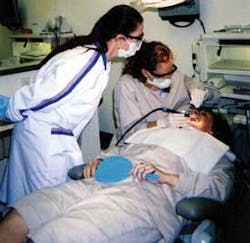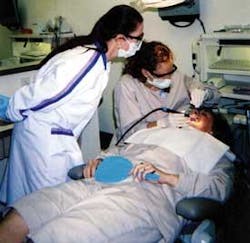Creating & Maintaining Beautiful Smiles
A patient veneer care system protects the patient’s investment by ensuring periodontal status and home-care compliance remains optimal.
Esthetic dentistry is becoming increasingly popular every day. Just turn on the TV to find a variety of “makeover” reality programs. The TV programs feature smiles that show off well-done veneers and other beautiful smile enhancements. These porcelain veneers often are done so skillfully that it may even be challenging to detect these quality restorations when patients arrive in our treatment rooms.
A new smile comes with new ways to care for it. Proper recare maintenance during hygiene visits should be an important aspect of clinical time management. The dental practice can support the beauty, the durability, and the longevity of porcelain veneers with proper care given in our treatment rooms - and with proper home-care instructions given to the patient. However, the patient must perceive the value of the maintenance interval, and how critical the maintenance system is to their periodontal health, their overall health, and to the investment of their beautiful smile!
This two-part article will review a complete patient veneer care system. Please review the philosophy and patient treatment strategies as a team for continuity, and decide as a group what you feel would work best for your patient base. A great strategy is to have all team members in agreement regarding your treatment protocols. Written maintenance instructions, accompanied with a compassionate chairside presentation, can be facilitated by the dental assistant when the veneers are seated. It is important to review your philosophy and protocols with the laboratory you are working with. Dental labs such as MicroDental Laboratories create the art and science of a beautiful smile with you. They can give you new insights on materials, and can be a great asset to successful maintenance support with your patients.
The number one, absolutely critical objective to the supportive maintenance of porcelain veneer restorations is an individualized recare strategy for your patients.
The recare interval should never allow the patient to have bacterial biofilm present long enough to create an inflammatory response. Clinicians need to take into consideration every variable of the patient’s health in order to quantify the proper interval. The following is a list of variables to consider:
• Current periodontal status - Is the patient currently periodontally stable?
• Current state of restorations - Are there any plaque retentive defective margins? (Incomplete treatment plans and/or newly defective margins)
• Current co-therapy compliance - Is the patient already compliant with their co-therapy or are they struggling with their daily regime?
• Current immune system response - Is the patient’s immune system stable or challenged?
• Occlusal discrepancies - Is the occlusion a contributing factor to periodontal health?
• Current stress factors - Are there are any major stress factors that could effect the immune system response?
• Current health and medications - Are there any medications that may be a contributing factor to the periodontal health and the inflammatory response?
• Current nutritional status and diet - Does the patient have a healthy nutrition/diet program?
The patient has made a significant investment in their new smile. We owe it to our patients to individualize their recare with a well thought out strategic interval to support their periodontal health and the longevity of the veneers. At each and every appointment we perform a risk assessment together with the patient to co-determine an appropriate interval for maintaining health.
The above questions are a list of specific variables that may impact the health of the periodontium. By utilizing a written list and checking off the appropriate variables of concern per individual patient, the patient can truly understand the necessity of the interval for their periodontal health. It is important to communicate the patient’s own individual variables with:
• Visual documentation of their written variables
• Visual brochures that indicate the significance of the immune system response, medications, or any of the periodontal variables
The visual documentation and review makes a huge impact on the value perceived by the patient. When you take the time to visually review the patient’s individual periodontal variables you can significantly decrease the number of cancellations and no-shows in hygiene. You also receive much fewer questions about why insurance does not cover the additional appointments.
A scenario could occur as follows: “Mary, let’s take a look together at what we feel would be the best interval for the maintenance of your beautiful new smile.”
The clinician and the patient would review the written list of the above variables and discuss which ones were pertinent to shorten the interval. You need to have written documentation that states, “For most adults to stay healthy periodontally they need to be seen between every 12 to 16 weeks” (depending on the current variables some of your patients may need to be seen as soon as eight to 12 weeks).
The American Academy of Periodontology offers great brochures for credibility and visual demonstration. If you choose to utilize a brochure by the AAP it is important to convey to the patient the sound reliability of AAP research. It would also be valuable for the patient to know that the AAP are specialists in the field of the gum health and jaw bone support. Most patients are aware of the American Dental Association; however, they are unfamiliar with the AAP. Show the patient pictures demonstrating how recession can effect the esthetics of the veneers. Review with the patient how inflammation will allow the gum tissue to pull away from the cervical margins.
The reward you will receive for co-reviewing the variables with the patient is their true perceived value of their “supportive therapy” interval. The reason why the patient moves away from insurance dictation and will comply to the recommended treatment is because they helped decide the timing of recare intervals, and the importance of the intervals becomes internalized.
The second part of this article will review what current products and instrumentation techniques are the most successful for your patient veneer care system. In the meantime, keep creating and maintaining those beautiful healthy smiles!
Peggy Sprague, RDH, is a co-founder of the The JP Institute, which has taught the most advanced clinical protocols, technology, and evidence-based science since 1979. The JP curriculum emphasizes team support for comprehensive dentistry. JP specializes in analyzing and refining practice philosophies, strategies and business systems, hands-on implementation of clinical skills, and technology and product integration. Call The JP Institute at (800) 946-4944 or visit www.jpconsultants.com for a complimentary practice or career profile to analyze your professional development, clinical protocols, technology and product integration, management systems, and profit potential.

